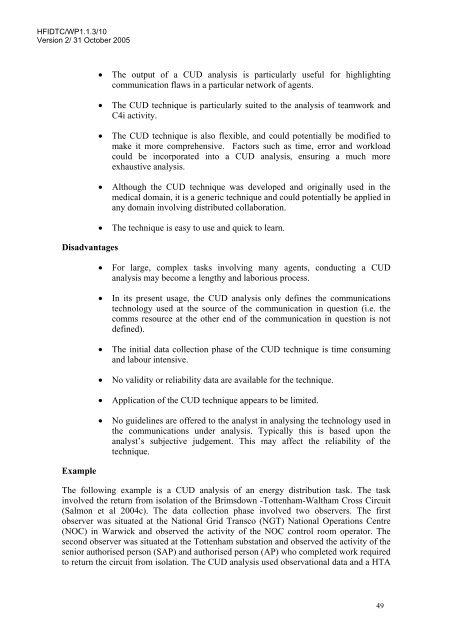A Review of the Event Analysis of Systemic Teamwork Methodology
A Review of the Event Analysis of Systemic Teamwork Methodology
A Review of the Event Analysis of Systemic Teamwork Methodology
- No tags were found...
You also want an ePaper? Increase the reach of your titles
YUMPU automatically turns print PDFs into web optimized ePapers that Google loves.
HFIDTC/WP1.1.3/10<br />
Version 2/ 31 October 2005<br />
Disadvantages<br />
Example<br />
• The output <strong>of</strong> a CUD analysis is particularly useful for highlighting<br />
communication flaws in a particular network <strong>of</strong> agents.<br />
• The CUD technique is particularly suited to <strong>the</strong> analysis <strong>of</strong> teamwork and<br />
C4i activity.<br />
• The CUD technique is also flexible, and could potentially be modified to<br />
make it more comprehensive. Factors such as time, error and workload<br />
could be incorporated into a CUD analysis, ensuring a much more<br />
exhaustive analysis.<br />
• Although <strong>the</strong> CUD technique was developed and originally used in <strong>the</strong><br />
medical domain, it is a generic technique and could potentially be applied in<br />
any domain involving distributed collaboration.<br />
• The technique is easy to use and quick to learn.<br />
• For large, complex tasks involving many agents, conducting a CUD<br />
analysis may become a lengthy and laborious process.<br />
• In its present usage, <strong>the</strong> CUD analysis only defines <strong>the</strong> communications<br />
technology used at <strong>the</strong> source <strong>of</strong> <strong>the</strong> communication in question (i.e. <strong>the</strong><br />
comms resource at <strong>the</strong> o<strong>the</strong>r end <strong>of</strong> <strong>the</strong> communication in question is not<br />
defined).<br />
• The initial data collection phase <strong>of</strong> <strong>the</strong> CUD technique is time consuming<br />
and labour intensive.<br />
• No validity or reliability data are available for <strong>the</strong> technique.<br />
• Application <strong>of</strong> <strong>the</strong> CUD technique appears to be limited.<br />
• No guidelines are <strong>of</strong>fered to <strong>the</strong> analyst in analysing <strong>the</strong> technology used in<br />
<strong>the</strong> communications under analysis. Typically this is based upon <strong>the</strong><br />
analyst’s subjective judgement. This may affect <strong>the</strong> reliability <strong>of</strong> <strong>the</strong><br />
technique.<br />
The following example is a CUD analysis <strong>of</strong> an energy distribution task. The task<br />
involved <strong>the</strong> return from isolation <strong>of</strong> <strong>the</strong> Brimsdown -Tottenham-Waltham Cross Circuit<br />
(Salmon et al 2004c). The data collection phase involved two observers. The first<br />
observer was situated at <strong>the</strong> National Grid Transco (NGT) National Operations Centre<br />
(NOC) in Warwick and observed <strong>the</strong> activity <strong>of</strong> <strong>the</strong> NOC control room operator. The<br />
second observer was situated at <strong>the</strong> Tottenham substation and observed <strong>the</strong> activity <strong>of</strong> <strong>the</strong><br />
senior authorised person (SAP) and authorised person (AP) who completed work required<br />
to return <strong>the</strong> circuit from isolation. The CUD analysis used observational data and a HTA<br />
49
















